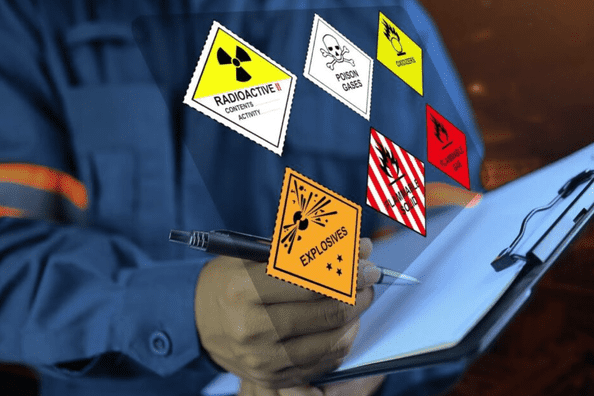
Blog
- Employer advice
Home
Resources
Health & Safety

Ikram Mohamed, Senior Health & Safety Advisor
(Last updated )

Ikram Mohamed, Senior Health & Safety Advisor
(Last updated )
Employers have a legal responsibility to keep their employees safe from harm in the workplace. Some employers must take extra precaution if the business uses, sells, or handles hazardous products or materials. Canada’s effort to heighten education about hazardous products and enforce protection of employees in the workplace led to the creation of WHMIS.
Workplace Hazardous Materials Information System (WHMIS) is Canada’s hazard communication standard for chemical use and exposure in the workplace. The standard includes hazard classification, worker education programs, cautionary container labelling, and the provision of safety data sheets (SDSs).
WHMIS was created in 1988 to keep workers safe by ensuring they have the information they need on using hazardous products on the job. It was updated in 2015 to align with the 5th edition of the Globally Harmonized System of Classification and Labelling of Chemicals (GHS). The legislation on WHMIS then came to be known as WHMIS 2015.
It was further updated in 2023 and is now referred to simply as WHMIS.
WHMIS is implemented on the federal, provincial and territorial (FPT) level, which makes it a national system of hazard communication for all workers in Canada. The policy also helps to ensure employer compliance regarding the sale, importation, handling, and storage of hazardous materials in Canada.
The key elements of WHMIS are:
WHMIS training is legally required for workers who will be exposed or likely to handle, store, use, clean, and dispose of hazardous products. This includes:
WHMIS training and education covers information on:
WHMIS training can be divided into two parts:
General training or WHMIS education is the general information about WHMIS, such as how WHMIS works, hazards of the products, pictograms, labels, regulations, safety data sheets, personal protective equipment.
Site-specific and job-specific training refers to the site- and job-specific information, which includes your workplace’s procedures for storage, handling, use, disposal, spills, emergencies, and how to respond in other situations.
Employers are required by Canadian jurisdictions to develop, implement, and maintain a WHMIS education and training program. All workers who are at risk for exposure to hazardous products must receive product-specific training.
It is the responsibility of the employer to provide all necessary information possible from the supplier on the hazardous products. Training programs must be reviewed for updates and changes at least annually. This review should include refresher training and take place every time:
Non-compliance with the law can lead to several consequences not limited to:
Health Canada’s amendments to the Hazardous Products Regulations (HPR) came into effect on December 15, 2022. The HPR is a federal legislation that sets the rules suppliers must follow to comply with WHMIS. These changes were made to align with the 7th revised edition, and certain provisions of the 8th revised edition, of the GHS.
Notable changes brought about by the amendments include:
Changes have also been made to the information elements required on safety datasheets.
These modifications provide more thorough and detailed health and safety information on product labels and safety datasheets, to ensure better protection for workers.
The amendments provide for a three-year transition period so that suppliers, employers, and workers have sufficient time to adjust to the changes. The transition period to switch to WHMIS from WHMIS 2015 will end on December 14, 2025.
Yes. If your workplace uses, stores, and handles hazardous products, you’ll need to update your education and training programs. You should also obtain your suppliers’ latest Safety Data Sheets (SDSs) before the December 2025 deadline. You will need to train your workers on any modifications to the hazard information on the new SDSs.
Peninsula can help. Our WHMIS training module has been updated to include all the new information that employers and workers need to know. Call us today at (1) 833 247-3652 to learn more about our WHMIS training.
A WHMIS certificate is a document that is issued by a training company to show proof of WHMIS training completion. While it is not a legal requirement for employers to have a WHMIS certificate, it is helpful in the event of an inspection since most employees in Canada are required to take WHMIS training.
There is no expiry date for the WHMIS certificate. However, it is a best practice to review the training program and conduct refresher training annually.
Peninsula’s experts are here to help you remain compliant and prepare for workplace inspections. Our qualified professionals can also help you to develop relevant health and safety policies and assist you with any health and safety advice you may need. To learn more about how our services can benefit your business, call us today at 1 (833) 247-3652.
Home
Resources
Health & Safety
Find out what 6,500+ businesses across Canada have already discovered. Get round-the-clock HR and health & safety support with Peninsula. Click below to unlock free advice, policies, e-learning, and more.
